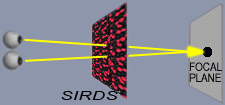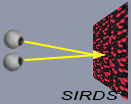Questions fréquentes sur les SIS
Questions fréquentes sur les SIS et SIRDS (Anglais)
TERMINOLOGY
SIS - (Single Image Stereogram) are holograms that do not need to be split in a pair in way to produce the stereoscopic effect.
Therefore, differently from the traditional stereo pairs, they do not require any device to be viewed.
Since the information related to the "depth" is embedded in a single image, they are also called "Autostereograms".
Various sub-types of images can fit in the definition of SIS, according to the way they are obtained. They are:

|
SIRDS
|
Single Image Random Dot Stereogram
are obtained through the repetition of a 2D texture made up of random dots.
|

|
SIRTS
|
Single Image Random Text Stereogram
SIRTS are obtained with a process that is similar to the previous, but the repetition is made up by random text characters.
|

|
SITS
|
Single Image Text Stereogram
SITS are made up by text written manually.
|
What SIRDS are?
SIRDS may be considered the result of a particular combination of a 3D image with a bidimensional pattern. The three dimensional image uses a scale of gray tones to store the depth information (Z-buffer image). In such a kind of representation, darker tones are associated to a greater distance from the observer.
The final image is then obtained through the repetition of a small texture in two directions. The repetition, however, does not occurs regularly and distorsions are introduced by the gray tones of the 3d image. At a first sight, human eyes can see only a strange pattern, but the hidden depth information will pop up in all its magnificence as soon as eyes will assume a relaxed status (focusing an imaginary plane that is located well behind the SIRDS).




Z buffer 3D image
2D texture
Hologram
How can I see the hologram hidden inside a SIS?
When eyes focus a point that is more distant than the plane where the SIS is physically located, the hidden 3D object suddenly and almost magically pops up (Figure A).
The process of focalization is the biggest obstacle for the observer, because eyes are naturally keen to converge on surfaces of real objects
(Figure B). The way the 2D texture is repeated also plays an important role in helping the observer to focus an imaginary plane that is located behind the SIS.
Figure A
 Figure B
Figure B
Each observer adopts its own technique to focus 3d shapes hidden inside sirds, but there is always someone that apparently is unable to see anything.
For these persons, the trick explained here below may help:
1 - Start positioning the face very close to the surface of the SIS (with the nose at approximately one cm from it).
At this distance, eyes cannot converge to the SIS, and they must necessary focus an imaginary point that is located well behind it.
2 - Go slowly backward, keeping the eyes absolutely immobile (imagine they are frozen). Just don't care if everything may look defocused at the beginning.
3 - As soon as you have the sensation to focus something, stop your movement and keep the eyes immobile.
4 - At this point the hologram should appear in few seconds.
If not, well... just do not lose the patience and restart from the point 1 :-)








 Figure B
Figure B